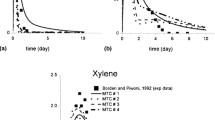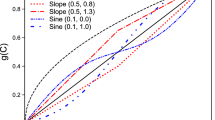Abstract
A three-dimensional model for contaminant transport resulting from the dissolution of multicomponent nonaqueous phase liquid (NAPL) pools in three-dimensional saturated subsurface formations is developed. The solution is obtained numerically by a finite-difference scheme, and it is suitable for homogeneous porous media with unidirectional interstitial velocity. Each dissolved component may undergo first-order decay and may sorb under local equilibrium conditions. It is also assumed that the dissolution process is mass transfer limited. The nonaqueous phase activity coefficients of the NAPL pool components are evaluated at each time step. The model behavior is illustrated through a synthetic example with a NAPL pool consisting of a mixture of TCA (1,1,2-trichloroethane) and TCE (trichloroethylene). The numerical solution presented in this work is in good agreement with a recently developed analytical solution for the special case of a single component NAPL pool. The results indicate the importance of accounting for the necessary changes in the organic phase activity which significantly affects the equilibrium aqueous solubility.
Similar content being viewed by others
Abbreviations
- C :
-
liquid phase solute concentration (solute mass/liquid volume) (M L−3)
- C s :
-
single component aqueous saturation concentration (solubility) (M L−3)
- C w :
-
equilibrium aqueous solubility (M L−3)
- D :
-
molecular diffusion coefficient (L2 t −1)
- D e :
-
effective molecular diffusion coefficient (L2 t −1)
- D x :
-
longitudinal hydrodynamic dispersion coefficient (L2 t −1)
- D y :
-
lateral hydrodynamic dispersion coefficient (L2 t −1)
- D z :
-
hydrodynamic dispersion coefficient in the vertical direction (L2 t −1)
- I():
-
integer mode arithmetic operator
- k :
-
local mass transfer coefficient (Lt −1)
- k * :
-
average mass transfer coefficient (Lt −1)
- L :
-
length
- l x ,l y :
-
pool dimensions inx andy directions (L)
- ll x ,l y :
-
x andy Cartesian coordinates of the pool origin (L)
- M :
-
number of moles remaining in a pool (moles)
- M′ :
-
initial number of moles (moles)
- n :
-
finite-difference scheme time level
- R :
-
retardation factor (dimensionless)
- t :
-
time (t)
- U x :
-
average interstitial velocity (Lt −1)
- x, y, z :
-
spatial Cartesian coordinates (L)
- X :
-
dimensionless mole fraction
- γ :
-
dimensionless activity coefficient
- η w :
-
viscosity of water (=0.8904 cp at 25°C)
- λ :
-
decay coefficient (t −1)
- τ * :
-
tortuosity (≥ 1)
- i,j, k :
-
finite-difference scheme grid indicators
- p :
-
component number indicator
- P :
-
total number of components
- s :
-
pure single component
- o:
-
nonaqueous phase
- w :
-
aqueous phase
References
Adenekan AE, Patzek TW, and Pruess K (1993) Modeling of multiphase transport of multicomponent organic contaminants and heat in the subsurface: Numerical model formulation. Water Resour Res 29(11):3727–3740
Anderson MR, Johnson RL, and Pankow JF (1992a) Dissolution of dense chlorinated solvents into groundwater, 1, Dissolution from a well-defined residual source. Ground Water 30(2):250–256
Anderson MR, Johnson RL, and Pankow JF (1992b) Dissolution of dense chlorinated solvents into groundwater, 3, Modeling contaminant plumes from fingers and pools of solvent. Environ Sci Technol 26(5):901–908
Banerjee S (1984) Solubility of organic mixtures in water. Environ Sci Technol 18(8):587–591
Borden RC and Piwoni MD (1992) Hydrocarbon dissolution and transport: a comparison of equilibrium and kinetic models. J Contam Hydrol 10:309–323
Carman PC (1937) Fluid flow through granular beds. Trans Inst Chem Eng London 15:150–156
Chrysikopoulos CV (1995) Three-dimensional analytical models of contaminant transport from nonaqueous phase liquid pool dissolution in saturated subsurface formations. Water Resour Res 31(4):1137–1145
Chrysikopoulos CV, Voudrias EA, and Fyrillas MM (1994) Modeling of contaminant transport resulting from dissolution of nonaqueous phase liquid pools in saturated porous media. Transport Porous Media 16(2):125–145
de Marsily G (1986) Quantitative hydrogeology, groundwater hydrology for engineers. Orlando, Florida: Academic Press. 440 pp
Fredenslund A, Gmehling J, and Rasmussen P (1977) Vapor-liquid equilibria using UNIFAC. New York: Elsevier. 380 pp
Geller JT (1990) Dissolution of non-aqueous phase organic liquids in porous media. PhD dissertation. University of California-Berkeley
Geller JT and Hunt JR (1993) Mass transfer from nonaqueous phase organic liquids in water-saturated porous media. Water Resour Res 29(4):833–845
Hayduk W and Laudie H (1974) Prediction of diffusion coefficients for nonelectrolytes in dilute aqueous solutions. AIChE J 20(3):611–615
Hunt JR, Sitar N, and Udell KS (1988) Nonaqueous phase liquid transport and cleanup, 1, Analysis of mechanisms. Water Resour Res 28(4):1247–1258
Johnson RL and Pankow JF (1992) Dissolution of dense chlorinated solvents into groundwater, 2, Source functions for pools of solvent. Environ Sci Technol 26(5):896–901
Lyman WJ, Reehl WF, and Rosenblatt DH (1982) Handbook of chemical property estimation methods. New York: McGraw Hill. 977 pp
Miller CT, Poirier-McNeill MM, and Mayer AS (1990) Dissolution of trapped nonaqueous phase liquids: Mass transfer characteristics. Water Resour Res. 26(11):2783–2796.
Pinder GF and Abriola LM (1986) On the simulation of nonaqueous phase organic compounds in the subsurface. Water Resour Res 22(9):109S-119S
Powers SE, Loureiro CO, Abriola LM, and Weber WJ Jr (1991) Theoretical study of the significance of nonequilibrium dissolution of nonaqueous phase liquids in subsurface systems. Water Resour Res 27(4):463–477
Powers SE, Abriola LM, and Weber WJ Jr (1992) An experimental investigation of nonaqueous phase liquid dissolution in saturated subsurface systems: steady state mass transfer rates. Water Resour Res 28(10):2691–2705
Press WH, Flannery BP, Teukolsky SA, and Vetterling WT (1992) Numerical recipes: The art of scientific computing, 2nd ed. Cambridge: Cambridge University Press. 963 pp
Schwarzenbach RP, Gschwend PM, and Imboden DM (1993) Environmental organic chemistry. New York: Wiley. 681 pp
Strikwerda JC (1989) Finite difference schemes and partial differential equations. Pacific Grove, California: Wadsworth & Brooks/ Cole. 386 pp
Stumm W and Morgan JJ (1981) Aquatic chemistry, 2nd ed. New York: Wiley. 780 pp
Voudrias EA and Yeh MF (1994) Dissolution of a toluene pool under constant and variable hydraulic gradients with implications for aquifer remediation. Groundwater 32(2):305–311
Wang HF and Anderson MP (1982) Introduction to groundwater modeling. New York: W.H. Freeman. 237 pp
Whelan MP (1992) Dissolution of non-aqueous phase liquid pools in saturated porous media. Master's thesis. Atlanta, Georgia, USA Georgia Institute of Technology
Author information
Authors and Affiliations
Rights and permissions
About this article
Cite this article
Lee, K.Y., Chrysikopoulos, C.V. Numerical modeling of three-dimensional contaminant migration from dissolution of multicomponent NAPL pools in saturated porous media. Geo 26, 157–165 (1995). https://doi.org/10.1007/BF00768737
Received:
Accepted:
Issue Date:
DOI: https://doi.org/10.1007/BF00768737




